While there are many different channels you can use to communicate with your potential customers, email remains one of the most compelling.
Email is 40 times more effective in acquiring new customers as compared to Facebook or Twitter.
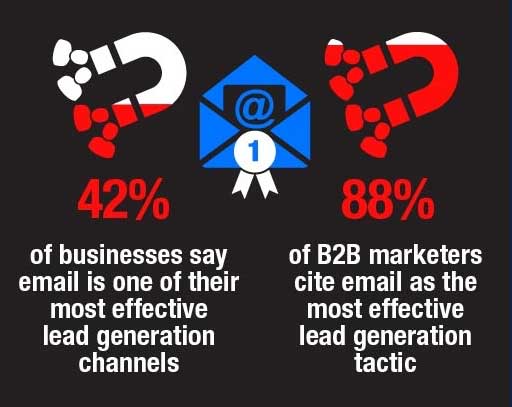
In this post, I will explain the steps we took in 2015 to grow our email list by 184%, adding 15,712 new subscribers.
Our history with email
We are big believers in email marketing. As a matter of fact, it is the one strategy we started using from the very first day at Invesp.
Over the last 10 years, we grew our email list in several ways:
1. Subscription box on the blog
We asked readers of the Invesp blog to subscribe to our email list in several locations.
We had a subscription box after each post.

We also had a subscription box in the right navigation of the blog.

2. Webinars
We conducted regular monthly webinars. Our webinars were highly popular, so they generated a stream of new subscribers to our email list.
3. Special offers and downloadable items
We created several tools, e-books, and whitepapers around conversion optimization and landing page optimization. In order to download these, website visitors had to subscribe to our email list. Our free landing page templates did particularly well in generating a stream of subscribers.
4. Conferences
We also exhibited at several online marketing and e-commerce conferences, which generated a list of subscribers from conference attendees, specifically those who visited our booth and engaged with our staff in a conversation.
Between all the different ways, our email list had about 8,500 subscribers at the start of 2015.
Why was the number of subscribers too low?
My goal in this post is to share some of the lessons we learned through the years of working with our blog and email service providers. The truth is our list should have been growing at a much faster rate, except that we had two major issues that hindered our progress:
1. Our blogging slowed down for a couple of years
Ayat and I were the two main bloggers at Invesp. As Invesp added more and more clients, we slowly found ourselves having to spend more time with clients and less time blogging. Writing a good post requires time investment. As our blogging slowed down, the list growth rate drastically slowed down.
2. Google penalty
With all the different Google updates, it seems we were hit with a penalty at some point in 2012. We lost a good chunk of the traffic that was coming to the website.
One of the side benefits of doing conversion optimization for the last ten years is our name and brand are recognizable. Although the Google penalty impacted our website, it did not kill our business. As the penalty resulted in fewer visitors coming to the website, the number of email signups slowed down as well.
Just as a side note, I have asked many SEO providers to look at our website. The answer I get constantly is that the website looks fine and that we have to wait for Google to run one of its updates. Google in its infant wisdom is yet to run the update.
Our email list growth goal
Our goal was to double the number of subscribers to our email list in 2015. Basically, in one year, we had to grow the list by the same number it took us nine years.
Challenging?
Maybe, but we were up to the challenge. More than that, it was exciting to set a goal and work hard to beat it.
Three challenges we faced growing our email list
Before we started increasing our email subscribers, we had to assess our email marketing program. Here are some of the challenges we found in our program:
1. Two different email service providers
Our email lists were distributed between two services:
- AWeber
- Constant Contact
We started using Constant Contact back in 2006, but it came with one major shortcoming. It did not support an automatic blog RSS to email feature. I am not sure if it currently supports this feature. Back then, we had first to collect our blog posts and then send them to subscribers.
To solve this problem, we started using AWeber, which provided an RSS to email service. This way, when website visitors subscribed to our email list, they started to receive weekly emails with our blog posts. However, AWeber email template left a lot to be desired.
So we ended using the two services, Constant Contact and AWeber.
Over the years, that decision was costing us time and became less and less manageable. Sending an email required creating two separate emails, using two distinct templates with two different email service providers.
If our plan was to grow our email list, this would become a real challenge.
We also wanted greater support for A/B testing our emails. AWeber supported A/B testing different headlines, but the functionality seemed limited.
Finally, open and click-through rates were not consistent between the two services. We are a conversion optimization agency, and we live and die by the numbers.
Not being able to analyze our numbers presented a huge problem for our team.
What is email open rate?
Email open rate is the percentage of email recipients who receive your email and open it. So, if you send an email to a list that has 10,000 subscribers and only 800 of them open the email, your email open rate is 800/10,000 = 8%.
Average email open rate differs from one industry to the next.
We have seen email open rates as high as 40% and as low as 1%.
Mailchimp provides a list of its own customers’ average email open rates.
What is email click-through rate?
Email click-through rate is the percentage of email recipients who receive your email, open it, and click on a link on it. So, if you send an email to a list that has 10,000 subscribers, 800 of them open the email, but only 150 click on a link in the email, your email click-through rate is 150/10,000 = 1.5%.
2. Inconsistent email schedule
One of the important components of email marketing is keeping it on a consistent and regular schedule. This ensures your list does not grow dormant as well.
We were sending our weekly emails using AWeber to our blog subscribers. But as our business grew, we had less time to blog, which meant our blog subscribers got fewer emails.
Obviously, this was more of an internal problem. Should we keep the inconsistent automated blog emails? Should we add other emails? We had to come up with answers to all of these questions.
3. Inconsistent webinars
Presenting webinars was a great strategy in 2012. Fewer companies were doing them at that point.
Things started to look a lot different in 2014. Webinars were everywhere. It became an overcrowded space. If you look in your inbox, you probably receive anywhere from 3 to 10 webinar invites per week.
We made the decision to stop our webinar program in 2014.
Was that a correct decision?
It is difficult to judge even now, after two years. More on this subject in a later post.
The problem with stopping our monthly webinars was we also stopped communicating with our email list regularly. The list became a little stagnant.
Growing our email list: a new plan of action
With all the problems I mentioned, our goal of growing the email list by 100% in one year seemed very aggressive.
To achieve this goal, we had to do the following:
Must be committed: this means content had to be produced, designed and emailed to our list on a regular basis. We would not be able to achieve our goal if we continued to ignore the blog and the webinars.
Must get creative: email marketing was easy ten years ago. Things are much different now. It is noisier now with so many companies using email marketing to get to their prospects. We had to find new and creative ways to reach our list and keep them engaged.
Must constantly test new elements and fine-tune them: Ultimately, we had to fine-tune our program and test different elements in it to find out which ones worked better.
Must give the new program enough time: Email is like any other marketing program. Marketing is not a light switch you turn on and off. It is a long term commitment.
Must allocate the required resources to manage the program: a successful email marketing program needs someone who analyzes the data, creates email templates, and sends the emails on schedule. You do not need to hire a full-time person if you are just starting out. You just need to have someone who will own the program and be responsible for it.
Five actionable items to revive our email program
We were excited, anxious and ready to start our email program. Here are the steps we took.
1. Using one email service provider
We had to decide whether we should continue using AWeber and Constant Contact or should unify our list.
The answer seemed simple enough.
It made no sense to continue using the two services. We were adding 2 hours of work for each email we sent. If we were going to send 3 emails per week, they would sum 6 hours of additional work someone from our team would have to waste instead of doing something more productive.
The next question was which service of the two we should go with.
AWeber had the nice feature of RSS to email.
Constant Contact had nicer templates and, for some reason, its open and click-through rates were higher.
Since we were leaving all options open, we decided to look for other service providers.
We evaluated the different services on the following criteria:
- Ease of creating templates and re-using them
- Ease of import of an email list from an external service
- Support for A/B testing
- Price
This list is by no means comprehensive, but it seemed to cover all the different items that were important to us.
We evaluated AWeber, Constant Contact, Icontact, Mailchimp, and Vertical response.
The truth is these email service providers ranked very close to each other on most of our criteria items.
Constant Contact was definitely a lead.
The one feature that seemed to cause a problem with many of the providers was importing new emails and adding them to the list. If we wanted to import our AWeber email list to Constant Contact, the service required us to send an email to every address we added asking them to confirm their subscription. If the person ignored the request to confirm his or her subscription, we would lose them forever.
That did not sit well with any of our team members.
We also wanted to use the name of the recipient in the email subject line. It seemed like an easy feature all providers should support. But that was not the case.
As we defined our requirements further, the field seemed to get smaller. We had to make a decision between Constant Contact and Mailchimp.
As we examined the two services, Mailchimp offered all the features we wanted. The one advantage Constant Contact had was the fact we were already using it. However, its requirement of requesting every imported email to re-subscribe to our list was simply a no-go for us.
Why do some of the email service providers require imported emails to confirm their subscription?
These providers want to keep the number of bounces and reported spam from their servers to a minimum. If you use one of these services to send spam, the service’s servers might be blocked. That would impact the service delivery rate.
I understand where these email services are coming from. But does it work for me? In our case, we had been customers of Constant Contact for ten years. We even offered them to see our AWeber account, so they could check the stats and make sure we were not spamming anyone, but they refused to change the requirement.
They did not seem interested in keeping our business, so we took it somewhere else. Now, I understand we were paying very little (less than $200/month), but Constant Contact forgot we also work with large clients and often help them with selecting email providers and optimizing emails.
We finally made the decision of switching our emails to Mailchimp. I will write a later post about our experience with Mailchimp and our email marketing program optimization.
2. Blogging more regularly
Sending blog updates to email subscribers is a great way to communicate with your audience.
But, in our case, we had to come up with a consisted blogging schedule.
Our initial content calendar had 100 topics on it. We assigned different topics to each of the partners and asked them to keep the blogging schedule.
I will write a detailed post about how we grew our blog readership in 2015.
When I look back at our plan and compare it to what we achieved last year, I can see we only managed to hit about 30% of our target.
Blogging is hard.
You have to be committed to it. Our blog readers fall in one of three categories:
- Marketing professionals who are interested in conversion optimization
- Executives of top online websites
- Small business owners looking to learn more about CRO
Each of these segments requires different types of material. One thing they all have in common is a need for deep insights. They are not looking for quick articles that provide generic and general knowledge.
Because of the Google penalty I mentioned above and the fact that we did not blog regularly for some time, our website traffic was modest.
Blogging results?
After maintaining an “okay” blogging schedule, we were able to increase our blog monthly visitors by 1000%.
A final note on the issue of emailing blog posts: we understood our decision to leave AWeber meant we could no longer rely on them to send our weekly RSS emails. We had to create these emails ourselves.
We decided not to send weekly emails to our list. Instead, we send monthly emails with our best blog posts. I cannot judge the effectiveness of this approach yet. This is something we plan to experiment with in 2016.
3. Bringing webinars back
One of the decisions we made was to bring the webinars back. They were an excellent source of both email list subscribers and leads for our consulting business.
The challenge was that too many companies were doing webinars at that point.
If we were going to rely on webinars to drive subscribers, we had to do the following:
Conduct webinars more regularly
The plan was initially aggressive. We would do 2 webinars per month. This proved to be difficult after doing webinars for 4 months. Each webinar required a lot of preparation and analysis. While our staff would put most of the material together, we still liked to do dry runs before the actual webinar. In addition, Ayat went on maternity leave for a couple of months, which left me carrying most of the webinar burden alone. By the end of the year, we switched to a schedule of one webinar per month.
Webinar’s studio
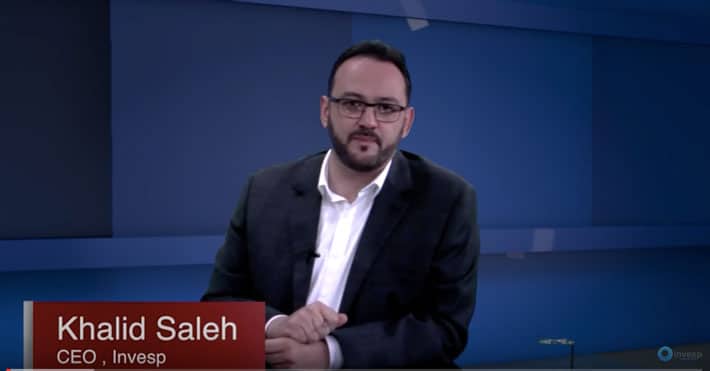
Since we wanted the webinars to stand out from the rest of the crowd, we started recording them in a full studio. While the final production was great, it took our staff quite a bit of effort until we managed to get to the final look and feel.
Testing
A lot of testing goes on with webinars. We tested:
- webinar topics
- email invites
- webinar scheduling
- as well as many other elements.
This is an on-going effort that produces good results for us. Our best webinars have close to 200 attendees in them. Webinar recordings get thousands more views on our Youtube channel.
4. Implementing an exit intent pop-up
With more blogging, we started to get more visitors to the website. As a matter of fact, our blog readership grew by close 1000% in 2015. We had implemented an exit pop-up back in 2012 offering blog visitors a chance to download free landing page templates in exchange for their email.
Some of the blog visitors complained about the pop-up and pointed it was not user-friendly.
We decided to bring the exit intent pop-up again in 2015. So, we evaluated several services.
Most blog pop-ups work the same way. As the visitor moves his cursor to leave the website, a pop-up opens and the visitor is asked to join the website email list.
The services varied in price from a few thousand dollars (bounce exchange) to little monthly fees (less than $50). In the end, we decided to go with OptinMonster.
We tested two different designs with the same copy:
1st Pop-up design
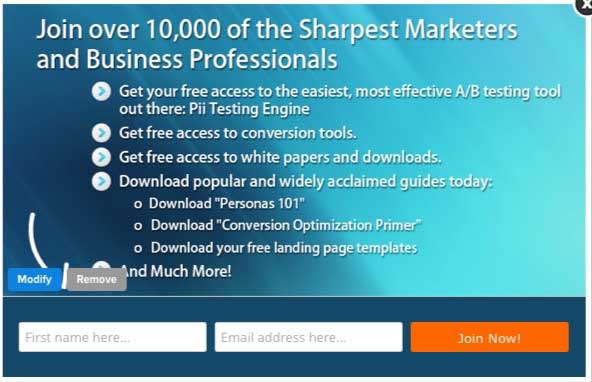
2nd Pop-up design:
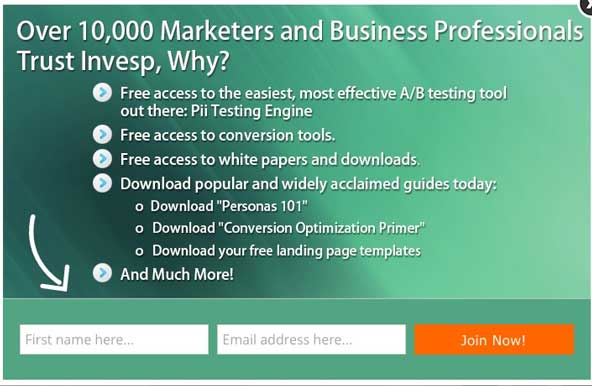
After running the test for a couple of months, design 1 was a clear winner converting 1.38% of the blog visitors into subscribers.
We then decided to implement a less intrusive side pop-up using SumoMe.
So visitors are presented with more options to subscribe.
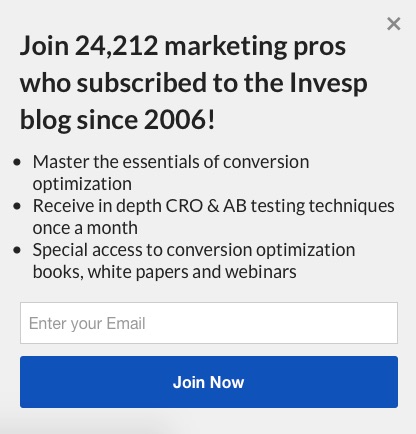
The side pop-up from KingSumo converted around 0.8%.
5. Conversion optimization books giveaway
In December of 2015, as a final push to increase the number of email subscribers, we launched a conversion optimization giveaway.
The giveaway offered contestants the option to enter their email into a drawing to win the top 10 books on conversion optimization. While the idea was good and we had close to 200 subscribers, the software we chose to implement the giveaway was disappointing.
After researching different options for the giveaway, we decided to use KingSumo since everyone was talking about how great the plugin was.
Our experience with KingSumo was not satisfactory. The software generated wrong URLs. We attempted to contact their support several times but did not hear back from them for 30 days. By the time they got back to us, the contest was over.
We might look at running the giveaway a second time, but we will have to think about what software to use.
Final thoughts
As we did each of the activities above, we saw our email list grow month after month. I cannot point to a single activity as the one that generated the most impact on the number of email subscribers. Using multiple successful methods is what got us to 24,212 subscribers by the end of 2015.



